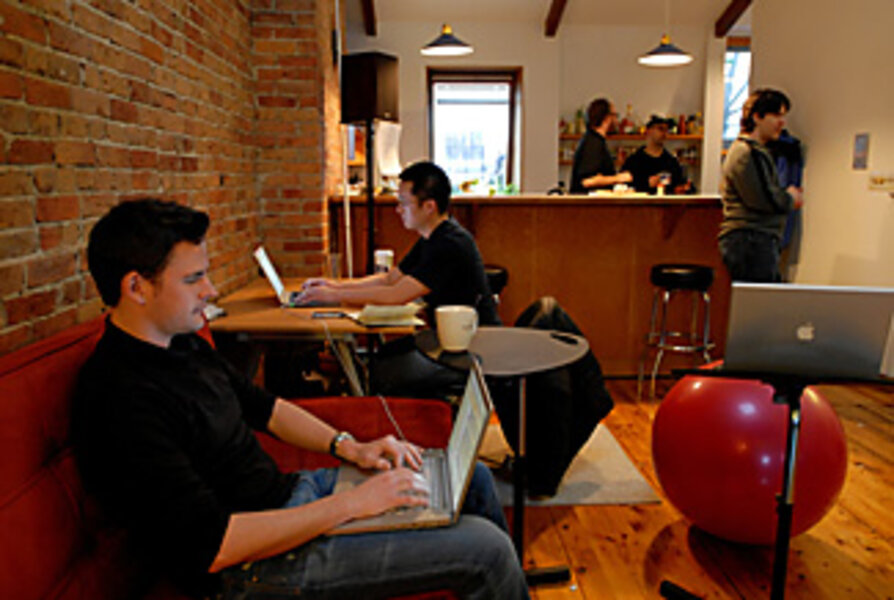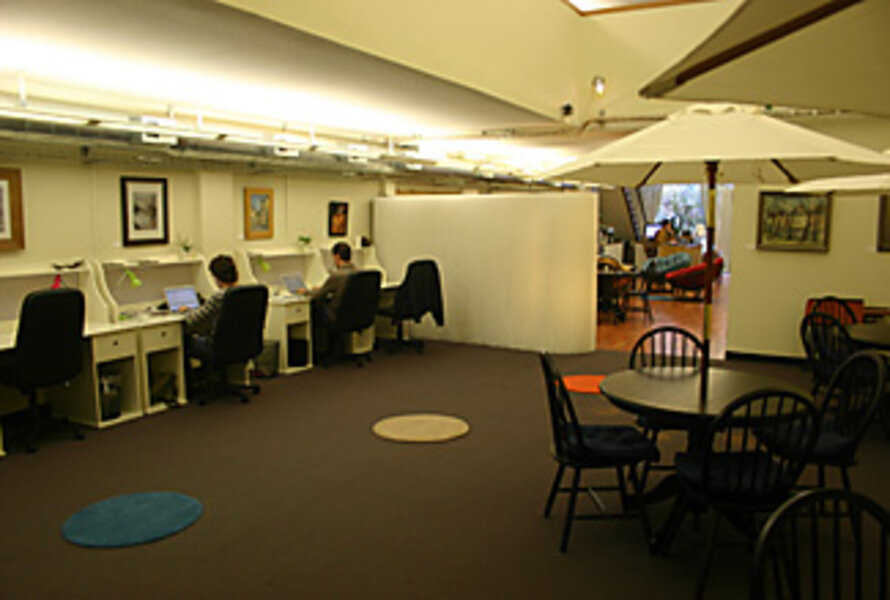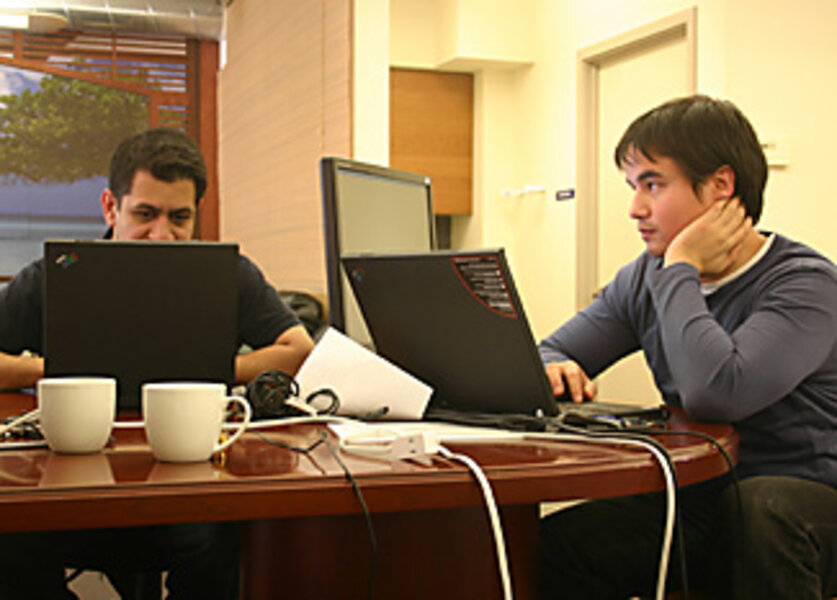Coworking: How to work solo, but not alone
Loading...
| Cambridge, Mass.
When Mike Jones signed on to be marketing director at an e-book publisher, one of the advertised perks was the chance to work at home full time. Two years later, he loves the job, but hated the location.
"I was totally cut off from the world," Mr. Jones says. "I was only working four or five hours a day because I'd keep looking for things to do just so I could get out of the apartment."
After months of searching for alternatives, Jones found Office Nomad, a shared workplace in Seattle that sells itself as "individuality without isolation." The studio plugs into a new and flourishing philosophy called "coworking."
The concept tries to combine the structure and socializing of a company office space with the flexibility of working from home. There are desks to rent, conference rooms to reserve, and still plenty of room to recline.
Coworking spots cater to the telecommuters, freelancers, and entrepreneurs of the e-mail era. These laptop bedouins represent a growing segment of the US workforce, and many coworkers say others are bound to find similar arrangements.
"I couldn't figure out why I had to choose between freedom and community," says Brad Neuberg, the computer programmer who coined the term coworking. "I wanted both. So I started imagining what that would look like."
In 2005, Mr. Neuberg found a woman's community hall in San Francisco that was empty during the day, and he struck a deal to use the space as the first coworking site. Every morning, Mr. Neuberg set up tables and waited for coworkers.
"For the first two months, no one showed up," he says, laughing at his initial hubris. "But people started trickling in and the word spread." Soon enough, he had started a movement.
There are now several dozen coworking spots across the country, and more popping up on other continents. Neuberg only had his hand in a few of them. Being an open-source developer, where software code is shared freely so it can be tweaked and improved by the community, he urged others to create their own coworking spots.
"I told people, 'Steal this idea. Turn it into whatever you want it to be,' " he says.
Coworking locations now come in every flavor: loose groups of individual workers such as Office Nomad, flats that have been converted into makeshift workspaces, and well-structured offices that tout more amenities than some corporate headquarters.
Sandbox Suites in San Francisco sports fingerprint-scan locks, ergonomic ball chairs, and macchiato coffees to order. Local artwork provides some eye candy, while the kitchen space offers the real deal, including Snickers and Crunch bars.
"I prefer it to working from home. I'm much more productive," says Heather Findlay, a local publisher. She can quantify her increased productivity: She's a month ahead of schedule from last year's publishing cycle.
Because of the shared costs, coworking spots are often a great deal less expensive than leasing a private office. Sandbox Suites costs $395 a month for five days a week. An extra $100 will get you a private desk. Office Nomad charges $25 a day for drop-ins or $475 a month for a dedicated desk that's available 24/7. Factor in the price of drinks at a neighborhood cafe, and the monthly fees aren't much greater.
An evolutionary step for start-ups
Among Sandbox's 20 regular denizens are the workforces of several start-up companies.
"I think there's a natural evolution of Internet companies nowadays," says James Nicholson, CEO of YourStreet Inc., a hyperlocal news website. "You start in your house, and then you move to a coffee shop, and then you move to a coworking space, then finally you get permanent office space."
One of the Sandbox start-ups is "graduating" to its own office in the weeks ahead. DanceJam, a video website focusing on dance, moved into Sandbox Suites a few months ago with three to four regular workers.
Now that venture funding has swelled its ranks to nine, plus a couple of interns, the workers have begun to outgrow the shared office and feel self-conscious about being the nosiest tenant in the space.
Noisy neighbors is part of the charm of Beta House, a coworking location in Cambridge, Mass. Taking up the top two stories of a multifamily house, the shared space feels like a techie fraternity. Electronic music is pumping. Someone had set up drum pads from the Rock Band video game. About half of the dozen coworkers tapped on keyboards, while the rest chatted in the open kitchen area.
"This place is a good mixture of all the things a young company needs," says AnYuan Guo, CEO of the video-based job counselor MyCareerTube.com. "There's networking, a place to get things done, collaboration."
Although most of the Beta House members work on their own projects, many stress how helpful it is to have other programmers around. They can pitch ideas, share hacks, and work through stubborn code. And because everyone is working toward different goals, there's no sense of office politics and little fear of ideas being stolen, says Jeff Dlouhy, a sophomore at Northeastern University who uses Beta House to get away from his dorm room and program new features for the open-source Web browser Camino.
"There's not that much competition," he says. "But sometimes there is a little geek envy."
Coworkers connect via the Web
Since the movement sprang from the open-source community, coworking uses many of the same self-organizing tools to spread the word. There's a coworking wiki site, several blogs, and countless Web pages devoted to promoting the idea and matching up workers with offices.
The main coworking location in Dublin, Ireland, grew out of a single website. "What we did was set up coworking.ie," just to see if there was any interest, says Jason Roe, an Irish freelance Web designer. He launched the site last March. By May, he had unveiled the first office. Another, larger space should be opening this month, he says.
The growth in coworking is no surprise to Rose Stanley, a work-life practice leader for the human resource association WorldatWork in Scottsdale, Ariz.
In 2006, the number of Americans who said they never telecommute dropped 24 percent, according to a study by WorldatWork. The fastest-growing segment was those who worked remotely every day, rising 20 percent to 14.7 million Americans. WorldatWork has yet to release the 2007 numbers, but Ms. Stanley expects the trends to continue.
In fact, with WorldatWork growing as a company, it's considering a situation very similar to coworking.
"Recently, we've been talking about opening a remote office," Stanley says. "But it doesn't have to be just for us. We've talked about sharing the space with other companies."
• Staff writer Ben Arnoldy contributed to this story from San Francisco.







